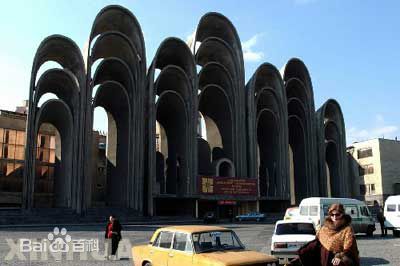 Georgia's economy sustained GDP growth of close to 10% in 2006 and 12% in 2007, based on strong inflows of foreign investment and robust government spending. However, growth slowed to less than 7% in 2008 and is expected to slow further in 2009. Georgia's main economic activities include the cultivation of agricultural products such as grapes, citrus fruits, and hazelnuts; mining of manganese and copper; and output of a small industrial sector producing
Georgia's economy sustained GDP growth of close to 10% in 2006 and 12% in 2007, based on strong inflows of foreign investment and robust government spending. However, growth slowed to less than 7% in 2008 and is expected to slow further in 2009. Georgia's main economic activities include the cultivation of agricultural products such as grapes, citrus fruits, and hazelnuts; mining of manganese and copper; and output of a small industrial sector producing
alcoholic and nonalcoholic beverages, metals, machinery, aircraft and chemicals. The country imports nearly all its needed supplies of natural gas and oil products. It has sizeable hydropower capacity, a growing component of its energy supplies. Areas of recent improvement include growth in the construction, banking services, and mining sectors, but reduced availability
of external investment and the slowing regional economy are emerging risks. Georgia has historically suffered from a chronic failure to collect tax revenues; however, the government has made great progress and has reformed the tax code, improved tax administration, increased tax enforcement, and cracked down on corruption since coming to power in 2004. Government revenues have increased nearly four fold since 2003. Due to improvements in customs and
tax enforcement, smuggling is a declining problem. Georgia has overcome the chronic energy shortages of the past by renovating hydropower plants and by bringing in newly available natural gas supplies from Azerbaijan. The country is pinning its hopes for long-term growth on a determined effort to reduce regulation, taxes, and corruption in order to attract foreign investment.
Location: Southwestern Asia, bordering the Black Sea, between Turkey and Russia
Population: 3,729,500 (2015 est.)
Land Area: 69700km2
Capital: T'bilisi
Main cities: Kutaisi, Batoumi, Sokhumi
Languages: Georgian 71% (official), Russian 9%, Armenian 7%, Azeri 6%, other 7%
GDP: $16.126 billion (2013 est.)
Monetary unit: lari
Exports: $1.908 billion f.o.b. (2007 est.)
Exports – commodities: scrap metal, machinery, chemicals; fuel re-exports; citrus fruits, tea, wine
Exports – partners: Turkey 12.7%, Azerbaijan 9.4%, Russia, 7.7%, Armenia 7.5%, Turkmenistan 7.3%, Bulgaria 6.4%, US, 6%,
Ukraine 5.8%, Canada 5%, Germany 4.6% (2006)
Imports: $4.725 billion f.o.b. (2007 est.)
Imports – partners: Russia 15.2%, Turkey 14.2%, Germany 9.5%, Ukraine 8.7%, Azerbaijan 8.7% (2006)
Land use: arable land: 11.51%
permanent crops: 3.79%
other: 84.7% (2005)
Natural resources: forests, hydropower, manganese deposits, iron ore, copper, minor coal and oil deposits; coastal climateand soils
allow for important tea and citrus growth
 Georgia's economy sustained GDP growth of close to 10% in 2006 and 12% in 2007, based on strong inflows of foreign investment and robust government spending. However, growth slowed to less than 7% in 2008 and is expected to slow further in 2009. Georgia's main economic activities include the cultivation of agricultural products such as grapes, citrus fruits, and hazelnuts; mining of manganese and copper; and output of a small industrial sector producing
Georgia's economy sustained GDP growth of close to 10% in 2006 and 12% in 2007, based on strong inflows of foreign investment and robust government spending. However, growth slowed to less than 7% in 2008 and is expected to slow further in 2009. Georgia's main economic activities include the cultivation of agricultural products such as grapes, citrus fruits, and hazelnuts; mining of manganese and copper; and output of a small industrial sector producing

